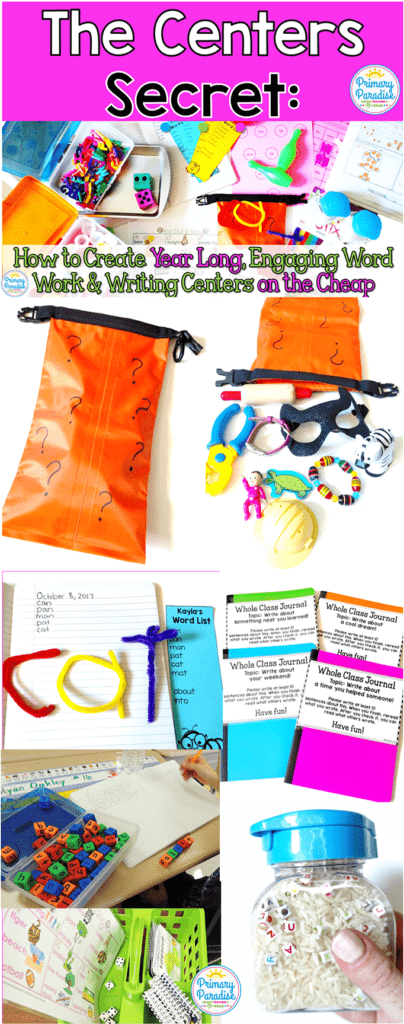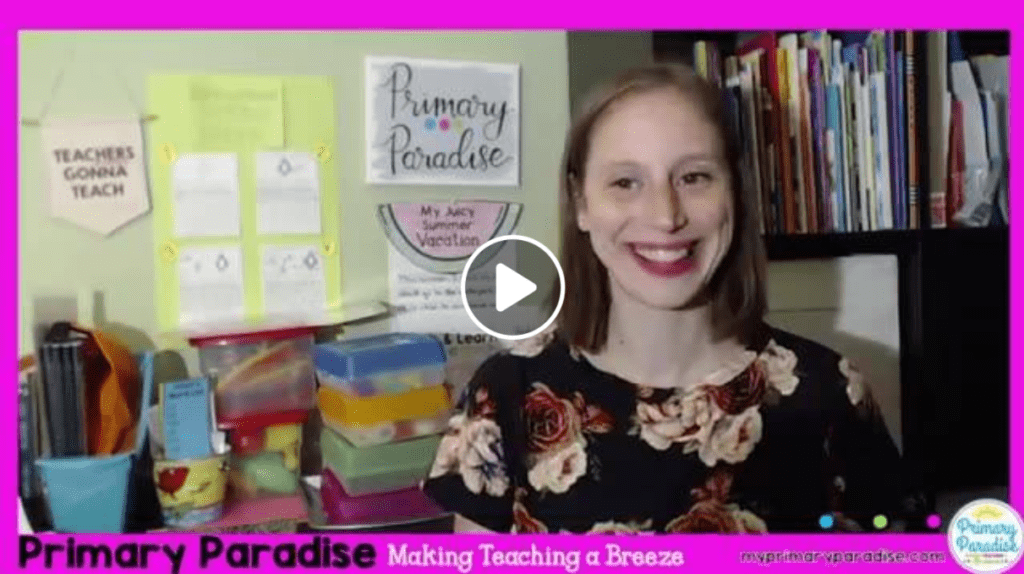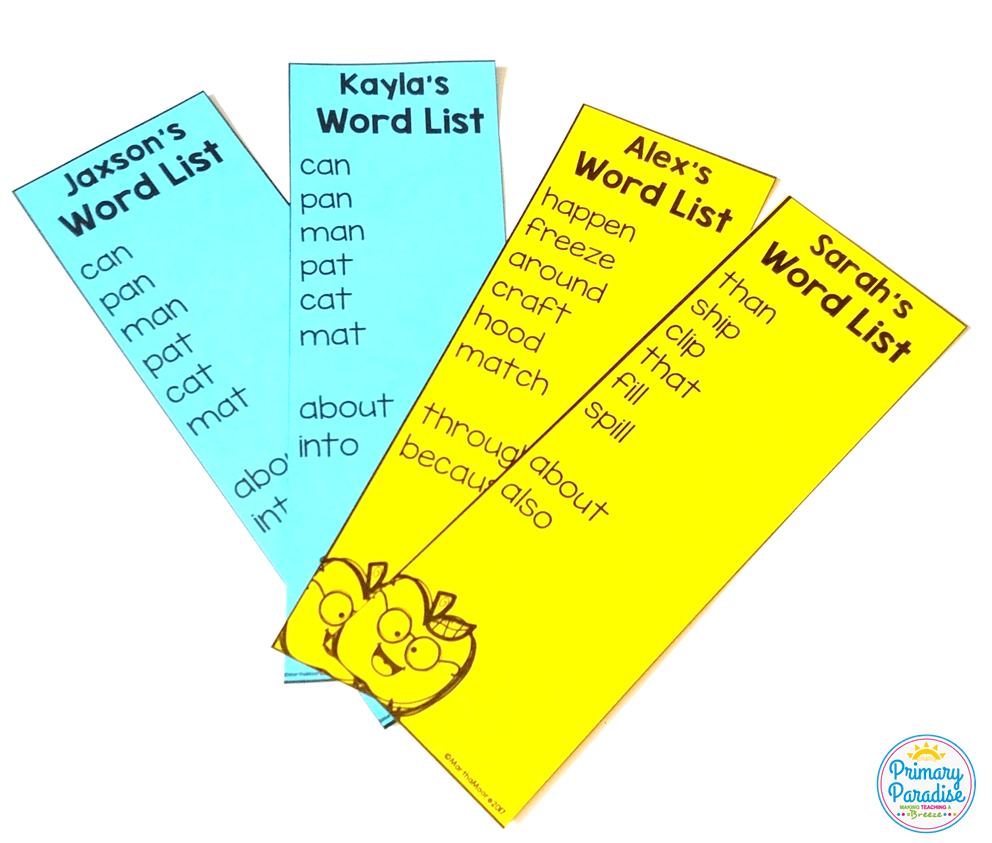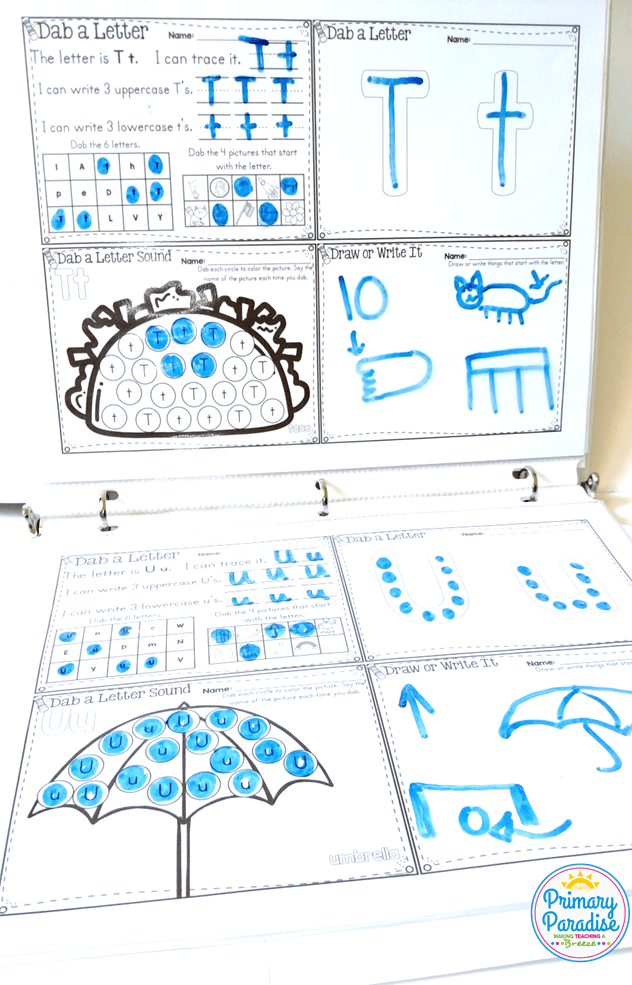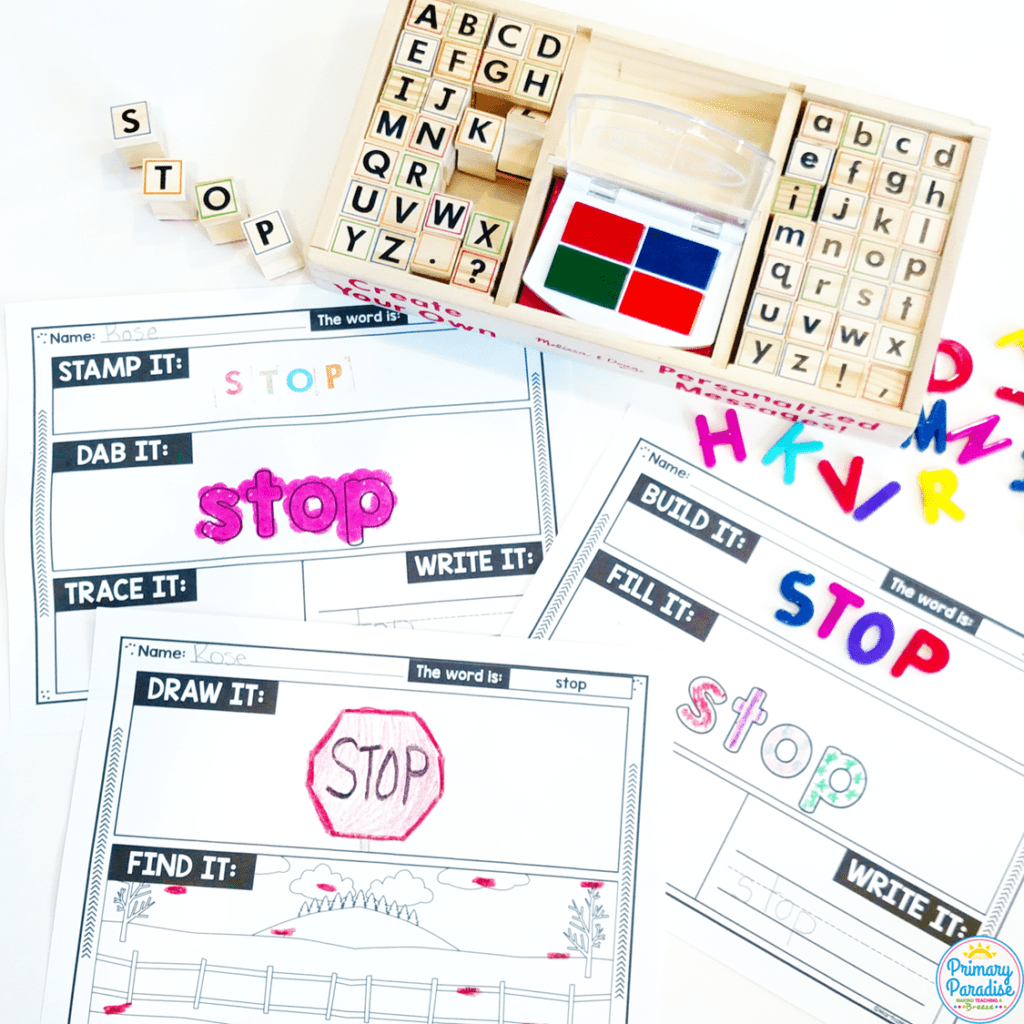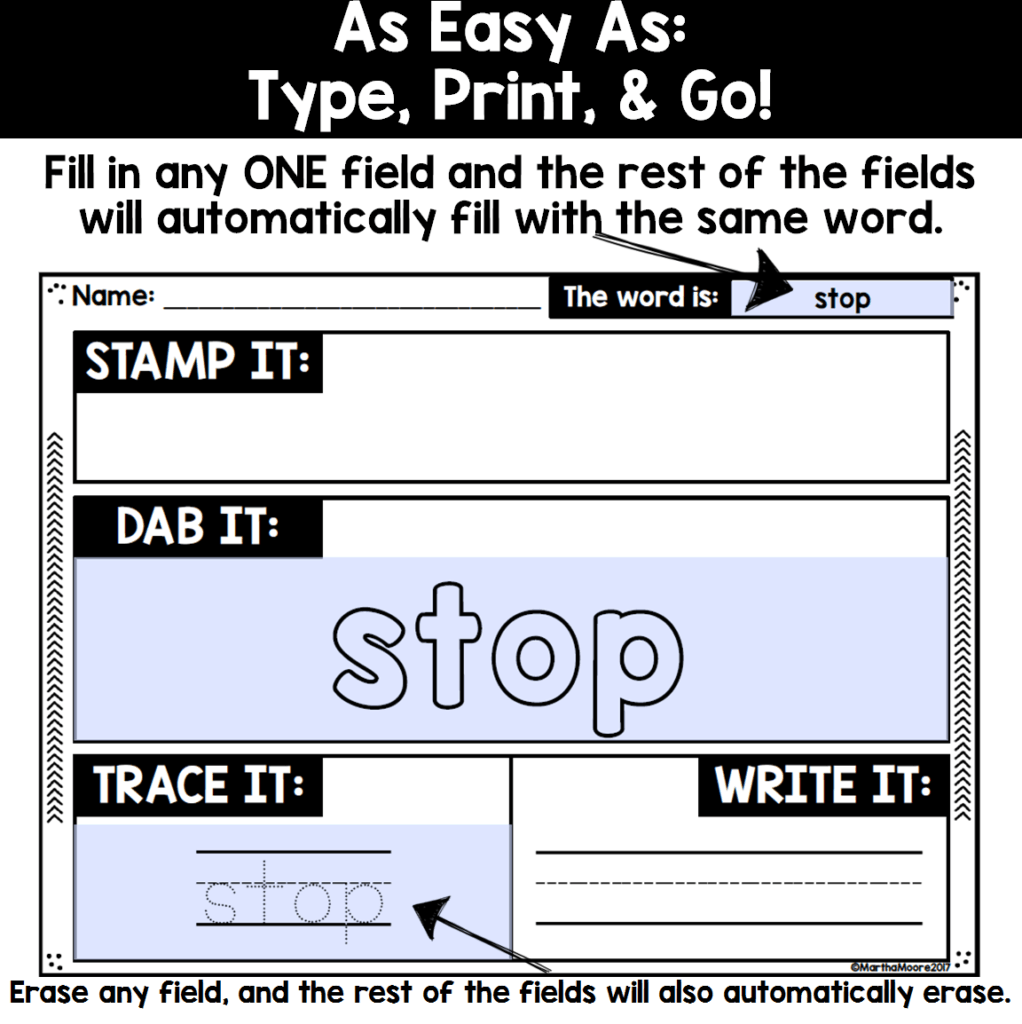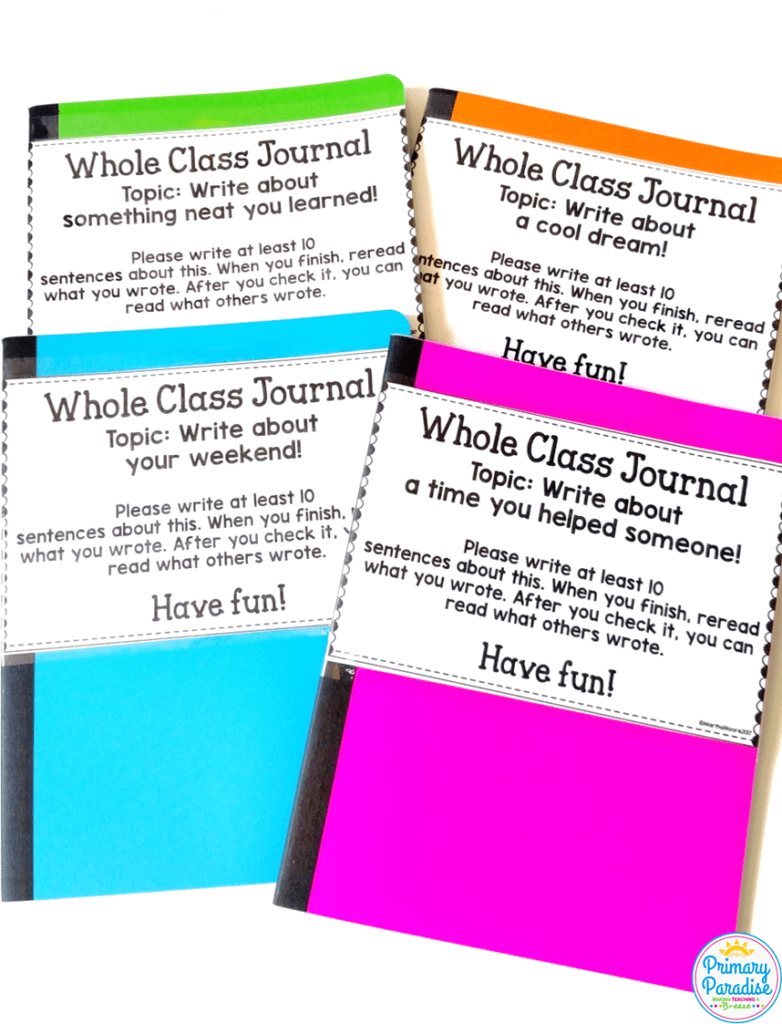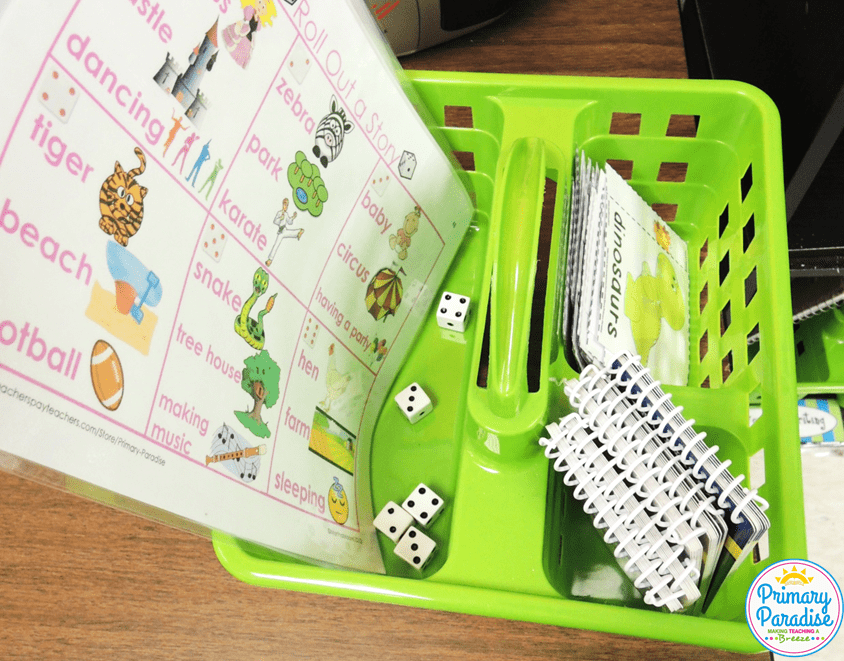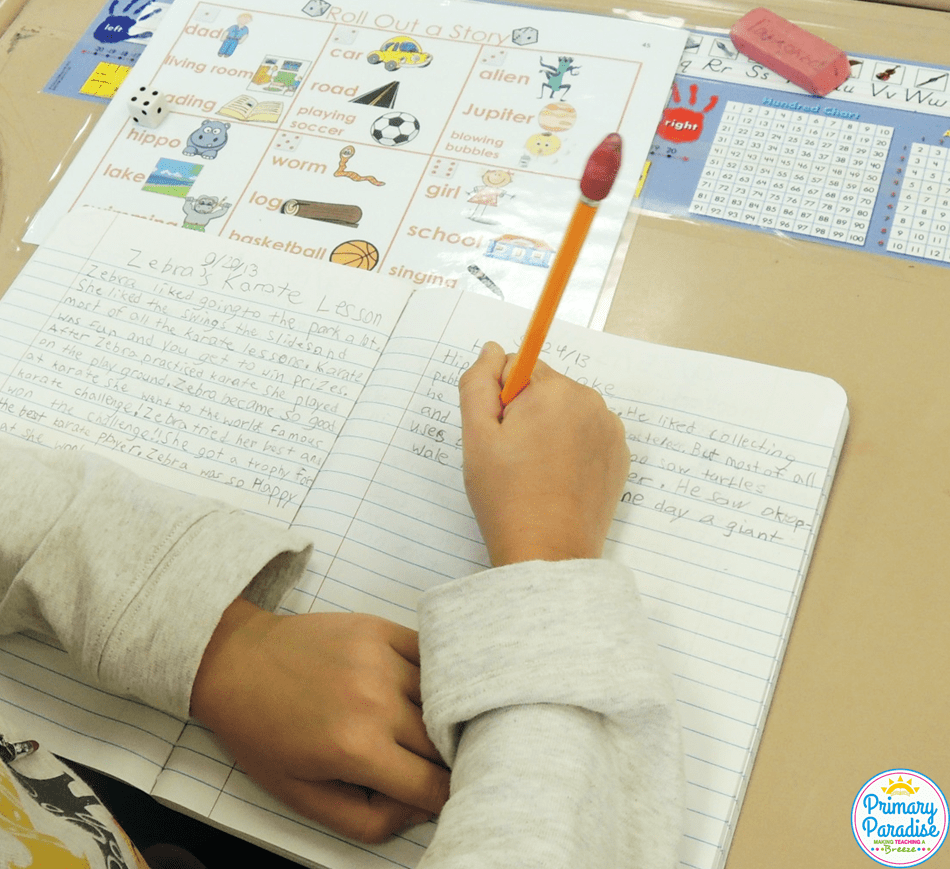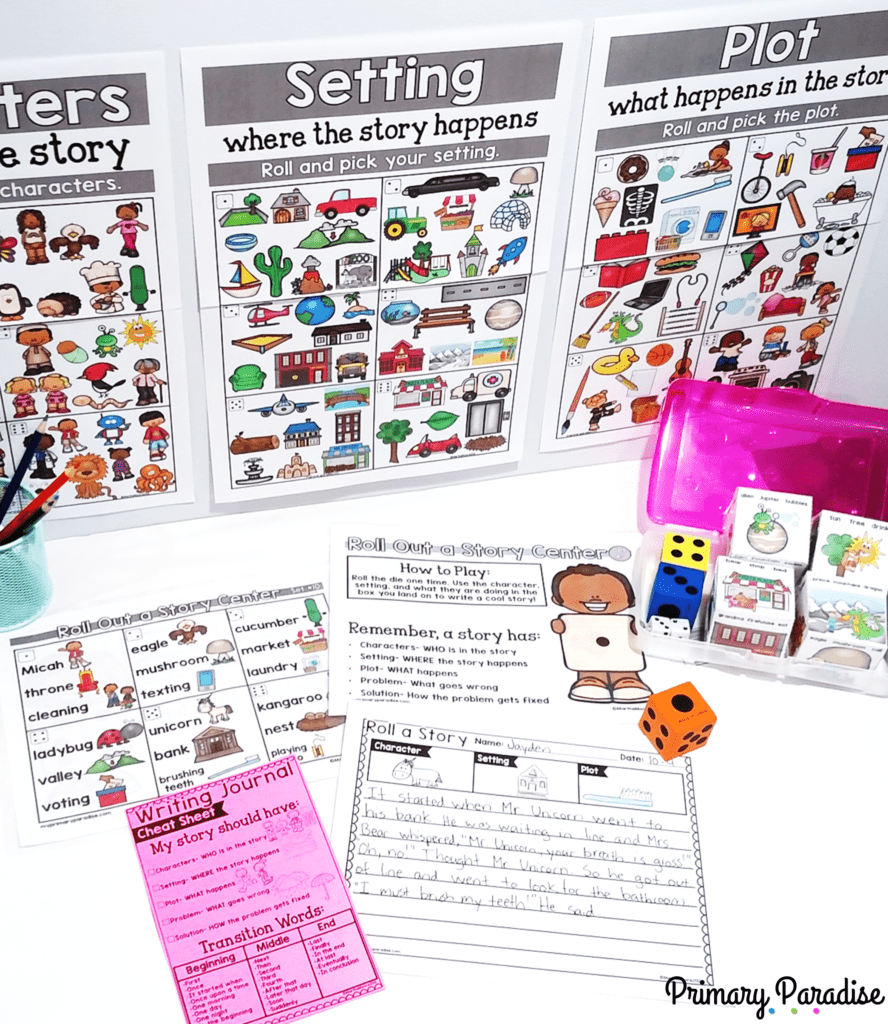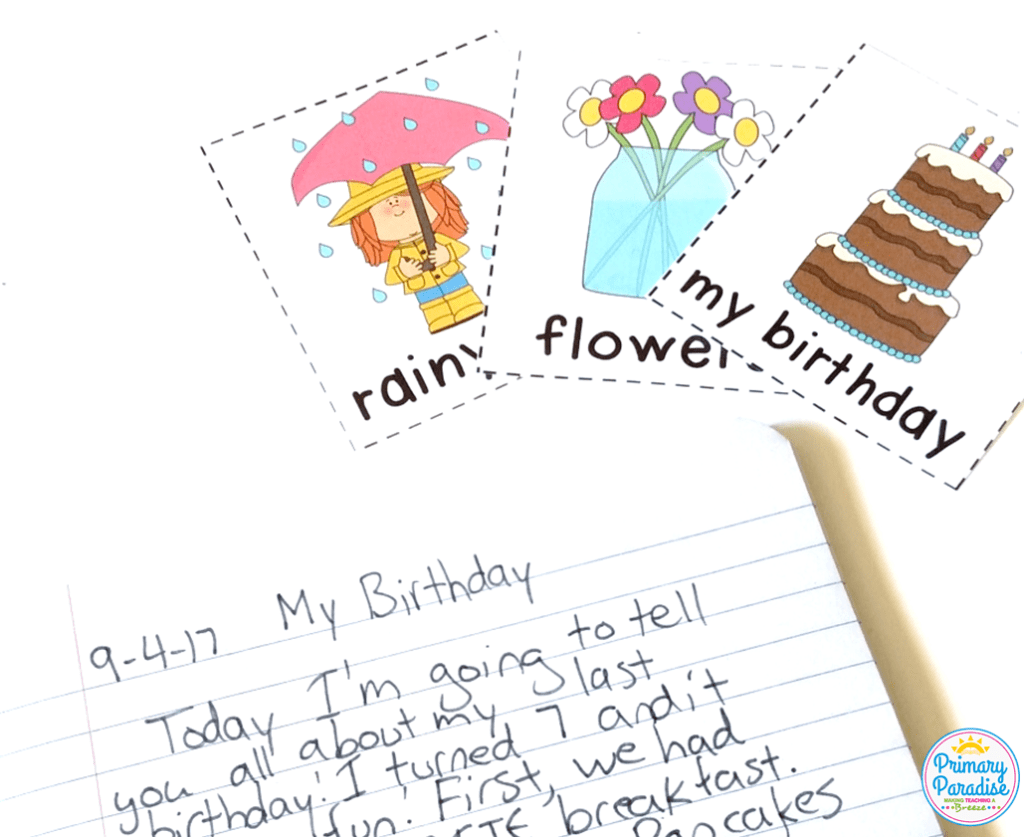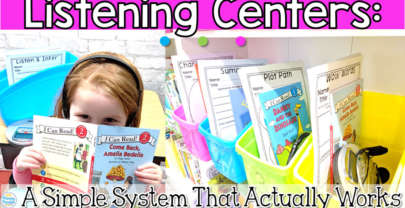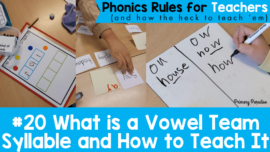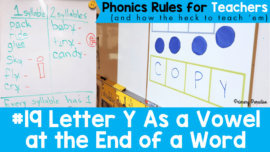Reading centers that are engaging for your students and cheap and easy for you? What if I told you that you also don’t have to change them all year and you can still differentiate at the same time? No, this isn’t the beginning of a really terrible joke, it is the reality in my classroom! And I’m excited to share my easy, engaging, and cheap word work and writing centers with you today!
I’ve written about word work and writing centers before, but today I’m going to go really in depth and share the why, how, and give you kid tested, teacher approved center ideas so you can stop cutting/laminating/prepping all year, and get back to teaching! These are my go to options to use during our reading center time. You can read about my listen to reading center set up here.
Looking for year long math centers? Click here!
So, let’s start with a little bit of the why, before we move to the how.
Watch my Facebook live on this topic here.
First, what exactly are we talking about?
However your classroom is set up, if you teach Kindergarten, 1st, or 2nd grade, you most likely utilize reading centers in some form. If you’re like me and use Daily 5, your students are reading to self, reading to someone, listening to reading, working on writing, or working on words. Even if you’re not using Daily 5, your literacy centers still probably include pretty much the same components. Today I’m going to focus on word work and writing centers because the other 3 categories are pretty self-explanatory. So, let’s get started.
What is the point of reading centers?
This is not a trick question. 😉 WHY do we have our students do word work and writing centers? Most likely, when your students are working on reading centers, you are pulling small groups to work on guided reading or other focused skills. So, we have the rest of our class complete centers. WHY? Here are (in my opinion) the key reasons reading centers are important.
1. To keep our students engaged while we work with other students.
2. To have our students practice working with words.
3. To have our students practice writing.
I promise I’m not being tongue in cheek here. I know those 3 reasons seem obvious and also unnecessary to state, but I think that, in the “hype” around centers, sometimes we get caught up in trendy, pretty, seasonal centers. Or, we get caught up in what’s popular. Or, we think we need to constantly change it up. But, I’m about to tell you a secret that will take a huge burden off of your shoulders. Are you ready?
You do not need to change your word work and writing centers throughout the year.
Well, more specifically, you do not need to change the word work and writing centers I’m about to share with you. You can keep the following centers all year long. All. Year. Long. In fact, my reading centers were used year after year after year. Sometimes I had to replace things here and there through normal wear and tear, but I used these same centers all year long. And guess what. My students enjoyed them and were engaged the whole year!
So, let’s dive in!
The centers stay the same, but the words change.
This post contains affiliate links.
As I stated, the centers stay the same all year. But, of course, the words that students are working on change. You can simply have your students work on their spelling/vocabulary words for the week, or you can give them differentiated word lists based on the words they need to focus on.
How do you know what they need to focus on?
You can learn this through small group instruction, sight word assessments, or maybe you have a program that your school uses. And, you can find some ready made word lists here and here. But, the key to these centers, no matter what words you give your students, is that the centers stay the same and the words are what is “new” each week. (Click here to grab these editable word list bookmarks.) Instead of focusing on the activity being new, you can focus on the excitement of learning new and fun words with activities the students will be able to complete independently with confidence!
Before we start:
Don’t feel like you need ALL of the following word work and writing centers. I don’t not use all of the centers every year. These are a collection of possible options. In order to keep things simple, I create duplicated of the centers I was using. So, I might have 2-4 of each option with a total of 5 word work choices and 5 work on writing choices, depending on the number of students in my class. And remember, You also have students who are reading to self, reading to someone, and listening to reading, so you don’t need word work centers for every student at once or writing centers for every student at once.
Here is what some of my set up looked like many years ago. See, nothing fancy, but it got the job done!
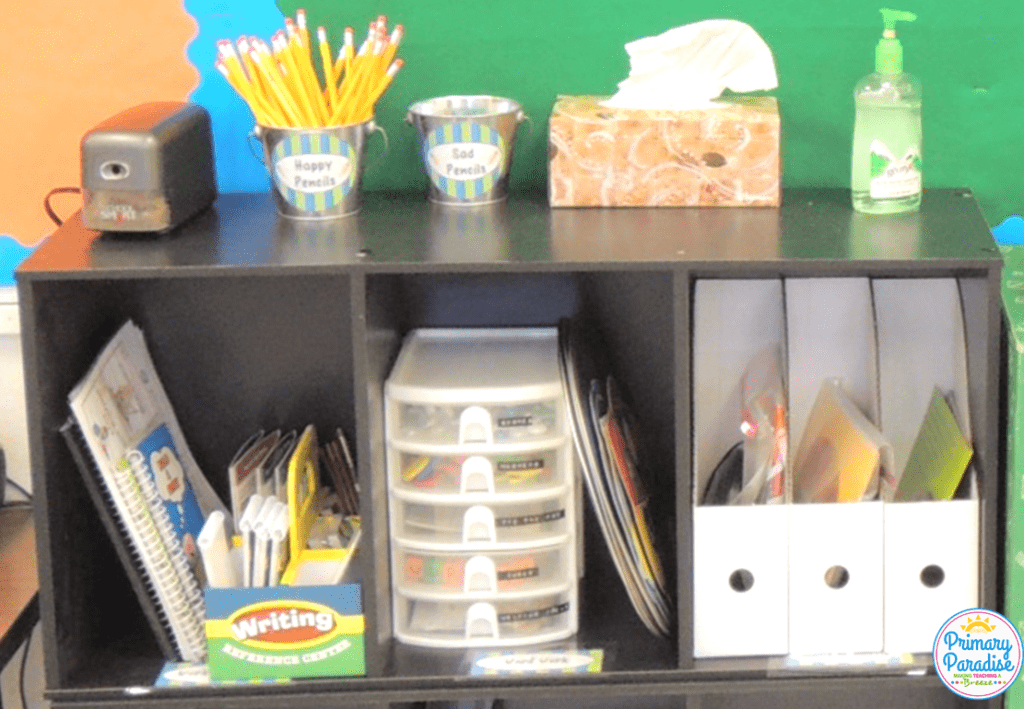
Here is where I house the majority of my centers now. This cabinet came with my classroom. It’s old, but I love it because they can pull the whole drawer out to work on their center.

And a few “house keeping” items.
-All of my students have a word work and writing journal (we use the same journal for both).
-Students are expected to write down every word they build in their journal (unless they’re recording somewhere else).
-Younger students (think k and early 1st grade) just write the word.
-Older students (end of 1st and 2nd) are expected to write the word in a sentence.
-If students finish all of the words on their word list, they’re expected to start again, pick words from the word wall, or pick words from their personal dictionary.
-Storage doesn’t have to cost an arm and a leg. I find pencil boxes work really well for storage and you can purchase them for $1 at Dollar Tree. I like to purchase a different color for each type center, if possible. (So all of the magnet centers are orange, all of the cube letters are green etc.)
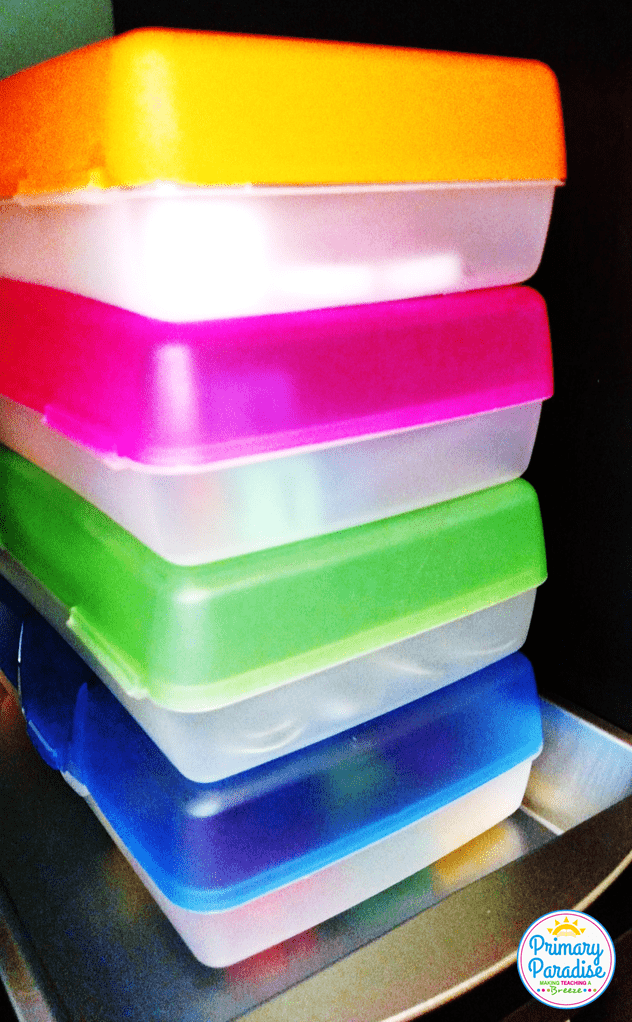
Word Work Centers:
Rice Shakers
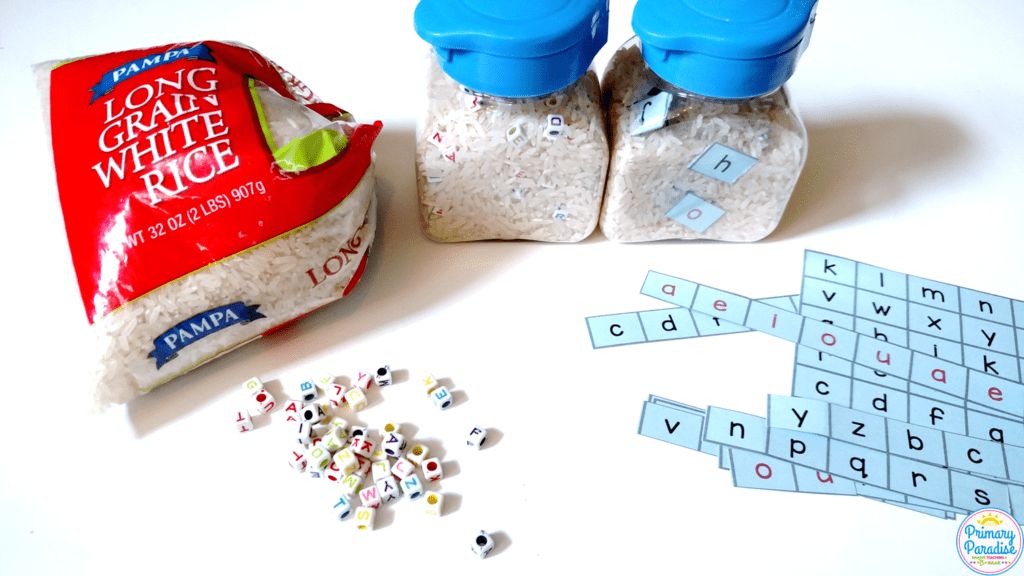
Rice shakers are fun, simple, cheap, and versatile. The containers, rice, and beads are all from the Dollar Tree. You could also use paper letters instead, although beads work the best.
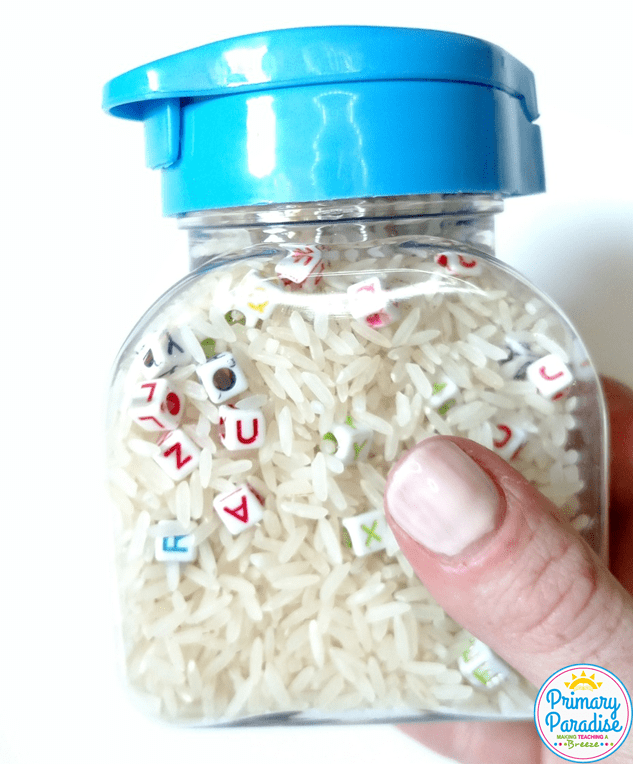
For kinders, especially at the beginning of the year, they shake the container and write the letters they see. If they find duplicates, you can have them write them on the same line.
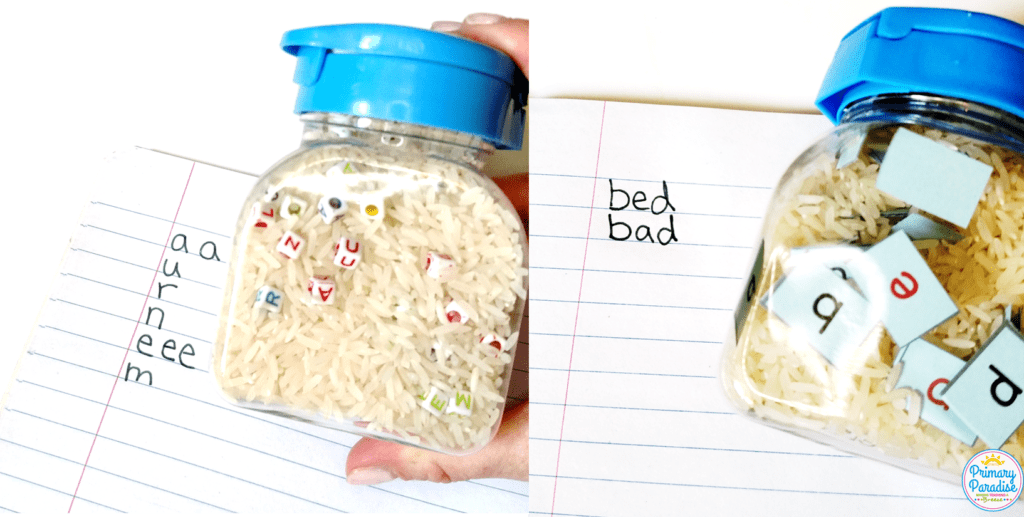
For first and second grade, students shake it up and write all of the words they can make with the letters they find. Another alternative is to write a word that starts with the letters they find. To make it even more fun? Add a mini magnifying glass so students can “hunt” for words.
Foam Cube Letters:
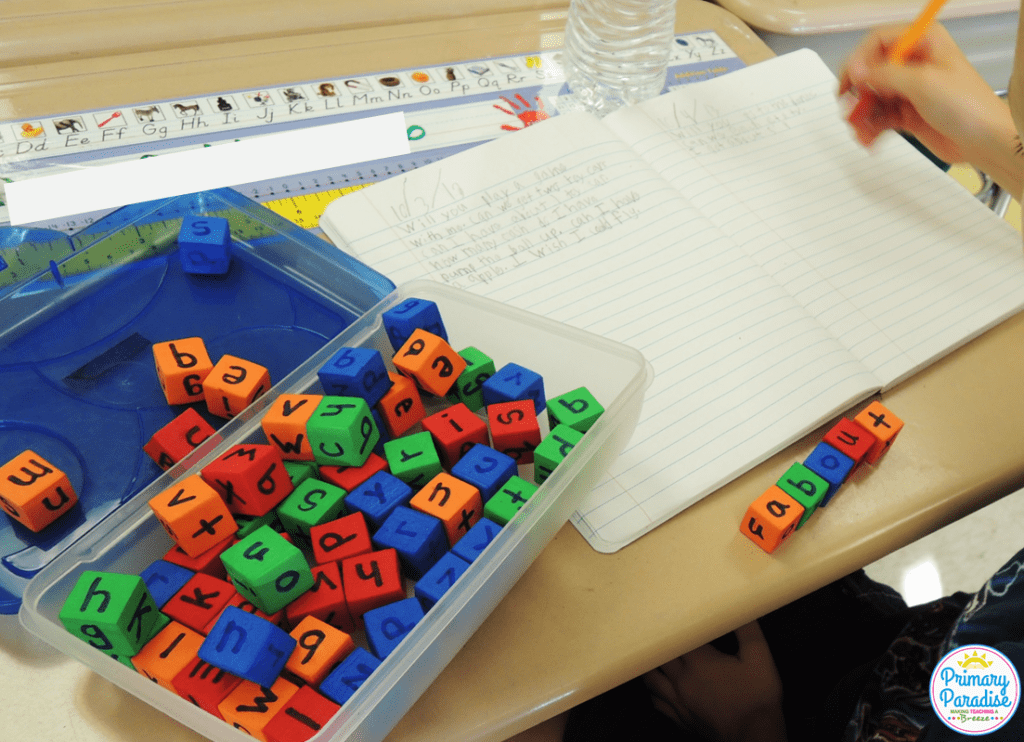
These fun foam cubes are from the Dollar Tree. I wrote the letters on with sharpies, and I like to put all of the vowels (a,e,i,o,u and y) all on one cube so vowels are easier to find.
For older/more advanced students, I require them to write their word in a sentence after they build it and underline the word. For younger students, I simply have them write the word.
Stone Letters:
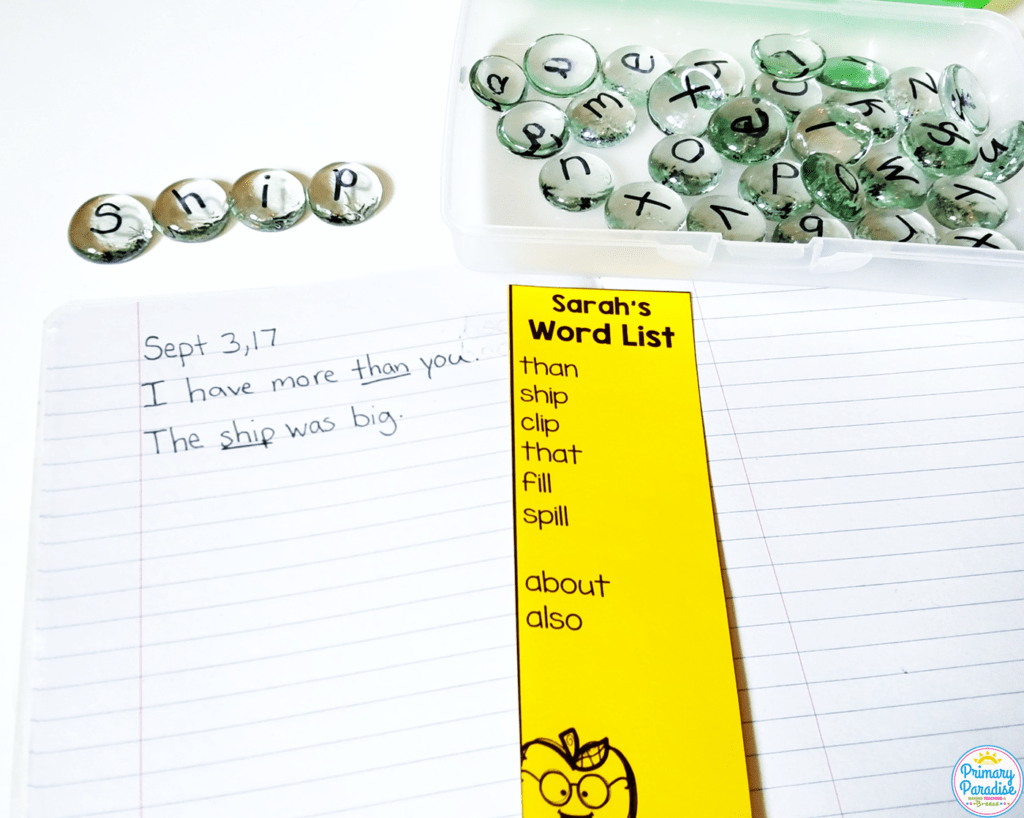
These stones are also from Dollar Tree. I like to include 2-3 of each letter for each center so it’s easier for students to find the letters they need and, as the year goes on, write more advanced words. The letters are written on with a sharpie, and after a year or two, sometimes a few rub off. I just rewrite them on, or with older students, if they notice a letter starting to rub off, I allow them to rewrite it.
Magnet Letters:
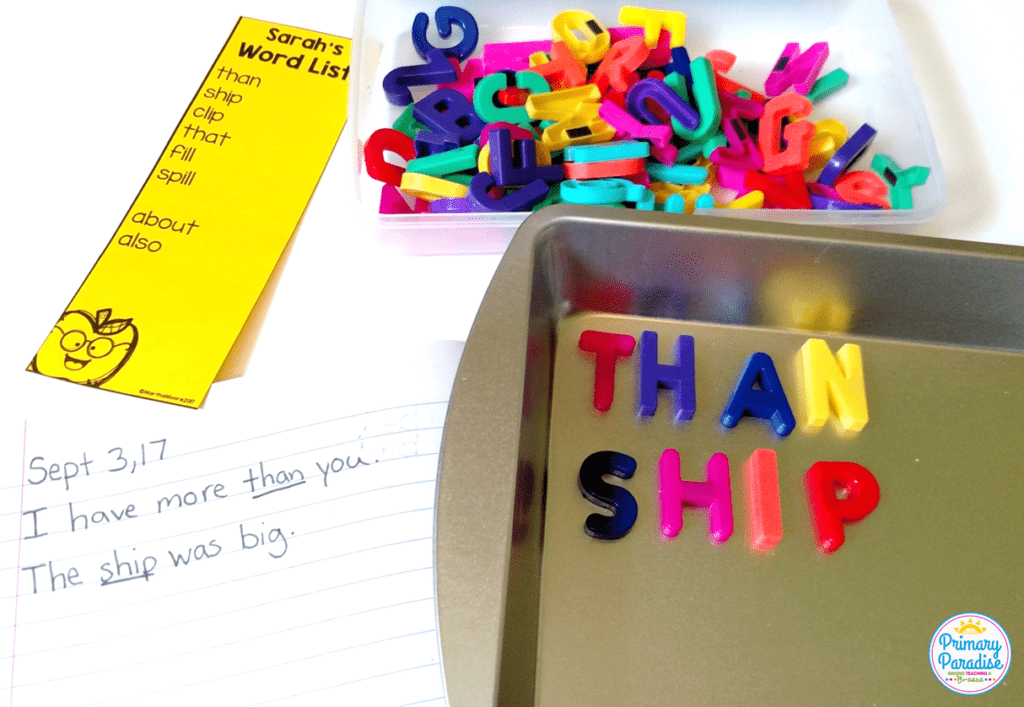
The pan is from the Dollar Tree (bring a magnet to make sure that it is truly magnetic) and I’ve purchased letters from Target and Dollar Tree in the past. Again, I purchase 2-3 sets for each bin so students have enough letters to make lots of words.
Bottle Cap Letters:
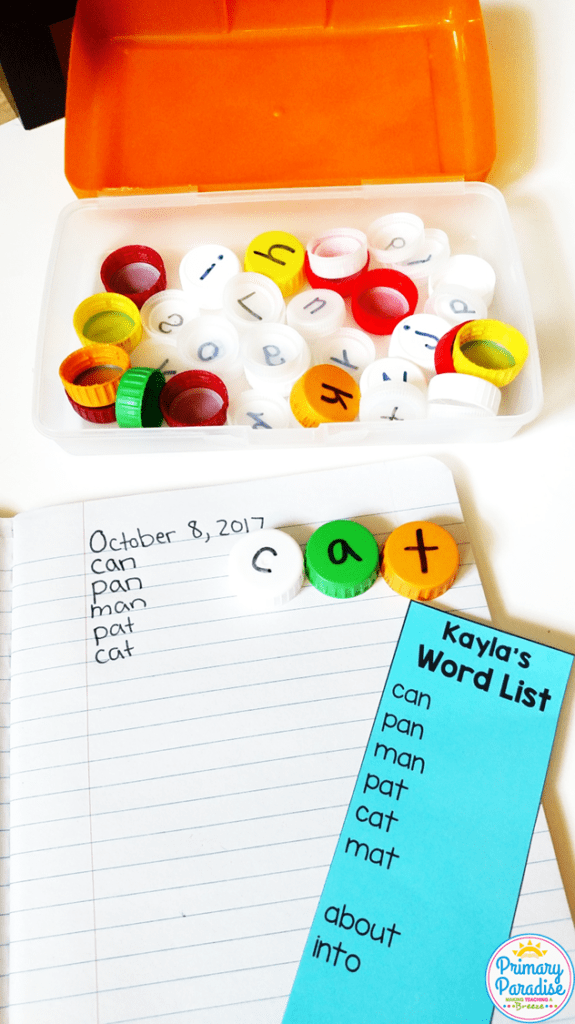
Another cheap option is making a bottle cap letters center! For older students, they can write the words from their list, and younger students could use free this template to match the letters.
Wikki Stix & Pipe Cleaners:
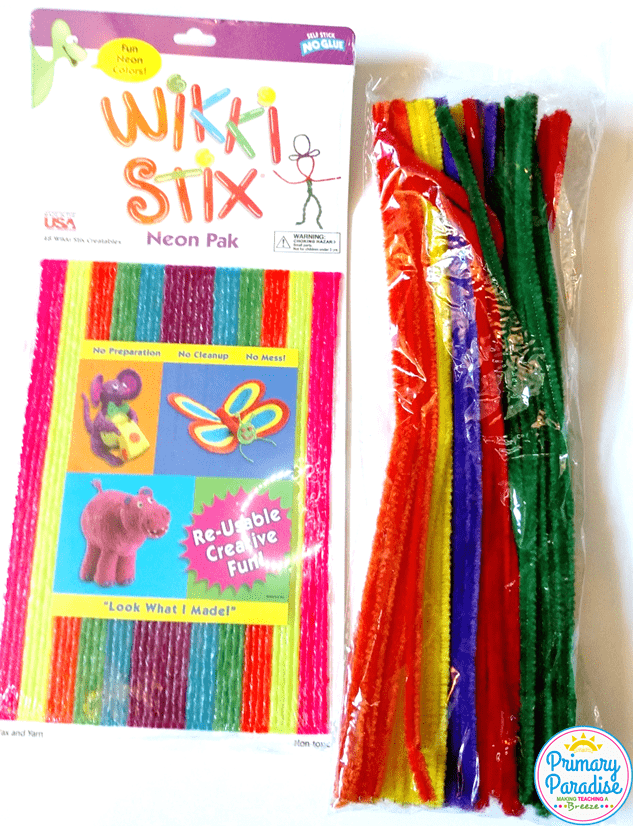
Students love building words with wikki stix, and I love how tactile this center is. Pipe cleaners are a cheaper alternative, but aren’t quite as easy to use (since they’re not sticky).
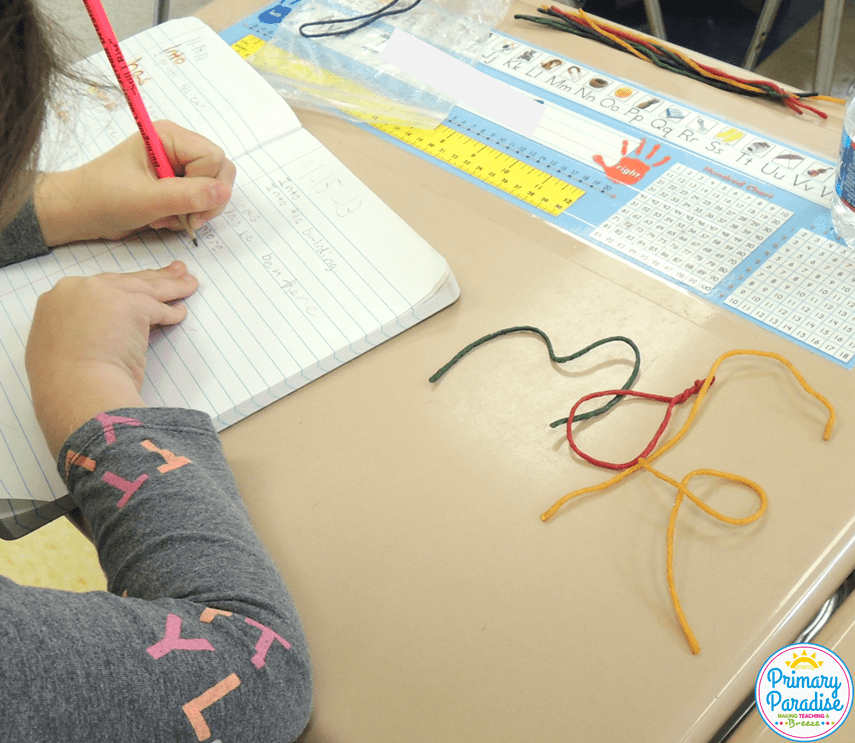
And my favorite storage for these? A Ziplock baggie. Storage doesn’t have to always be fancy, expensive, or cute! I will warn you that wikki stix typically only make it for 1 year at a time, but I do think they’re worth using.
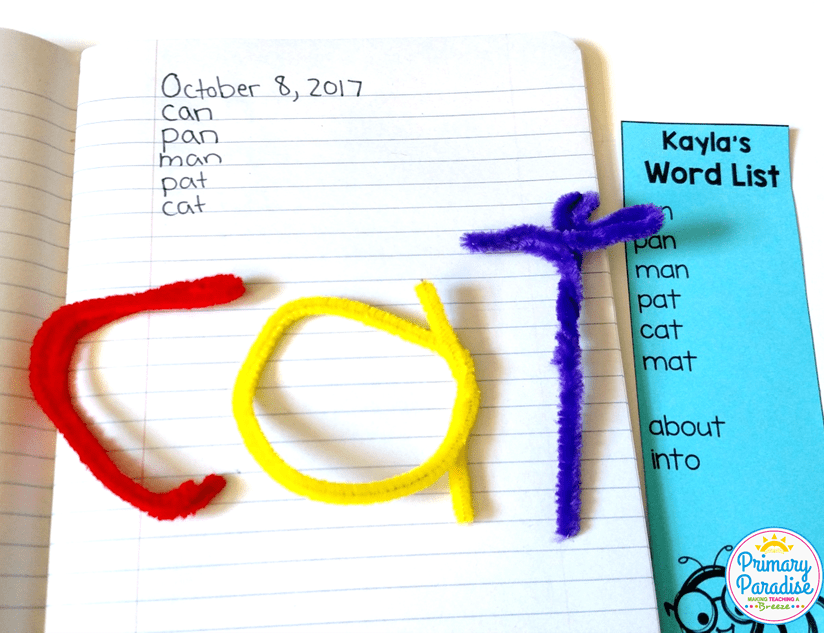
Tic Tac Toe:
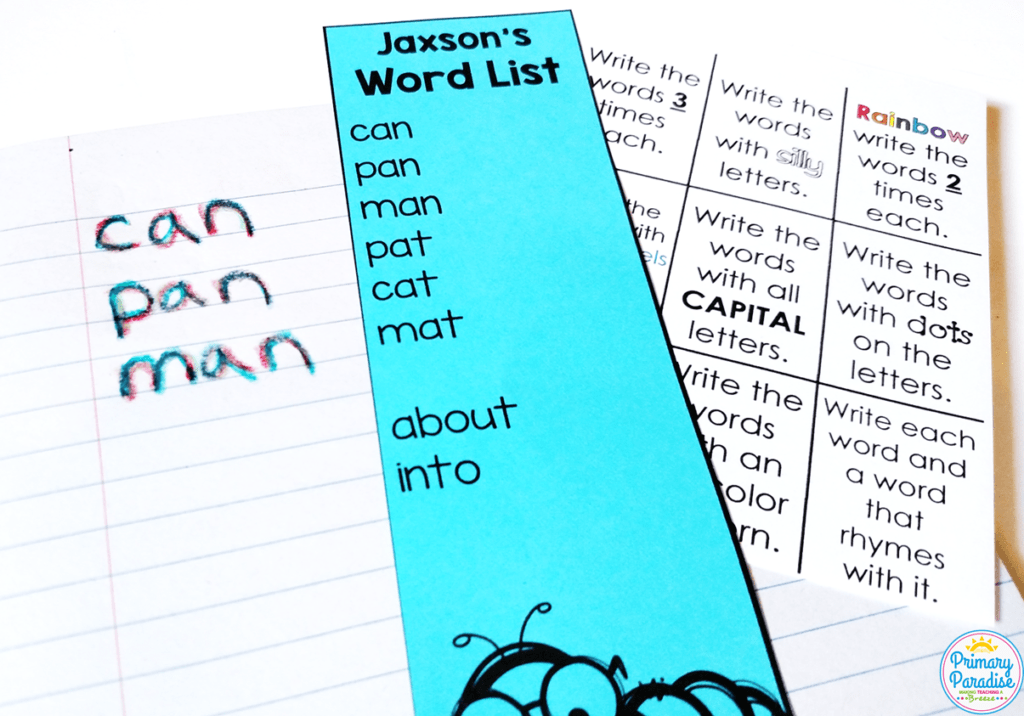
These tic tac toe boards are a freebie in my free resource library for email subscribers, and are always a personal favorite. These work well for 2nd graders, but might be too challenging for kinders and firsties. I laminate these so they last for years and years. Students pick 3 in a row to do with all of their words. When they finish? They pick another 3 in a row.
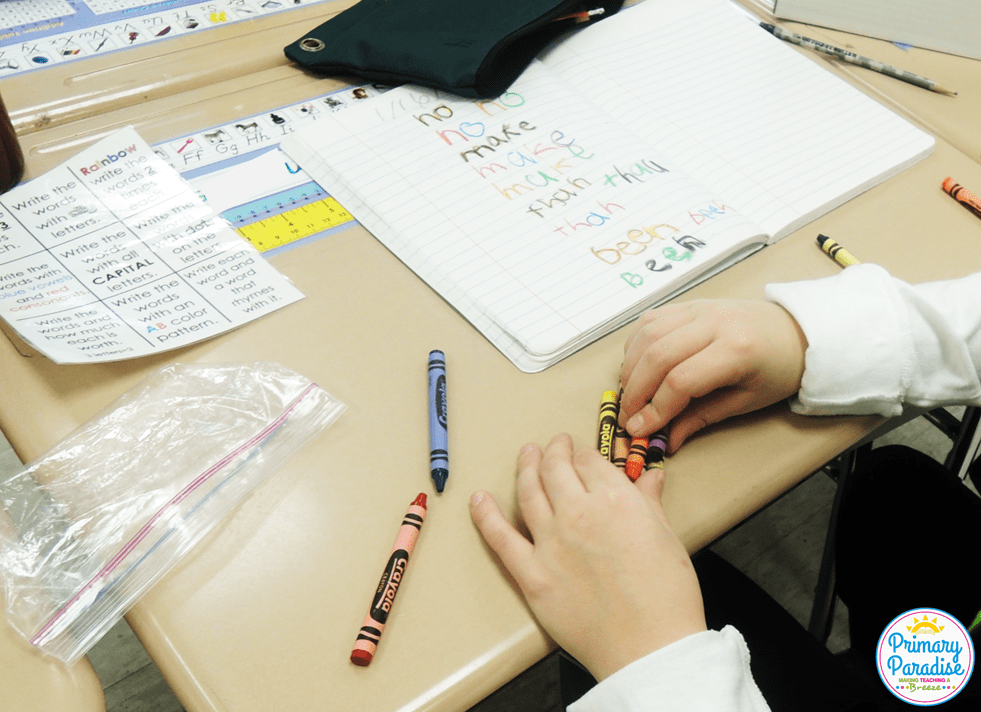
Those are my favorite all year, no prep centers for word work. I’m also going to share some ideas that do require a minimal amount of prep but generally use the same format over and over, require zero cutting, and are great for more intensive word work practice or having student practice in small groups.
Dab & Learn ABC’s:
This word work center is perfect for Kindergartners or for intervention/ review in first. In order to make these no prep and reusable, you can place them in plastic sleeves and have students use a dry erase marker. They’re also perfect for the small group table.
Bowl & Learn Sight Words: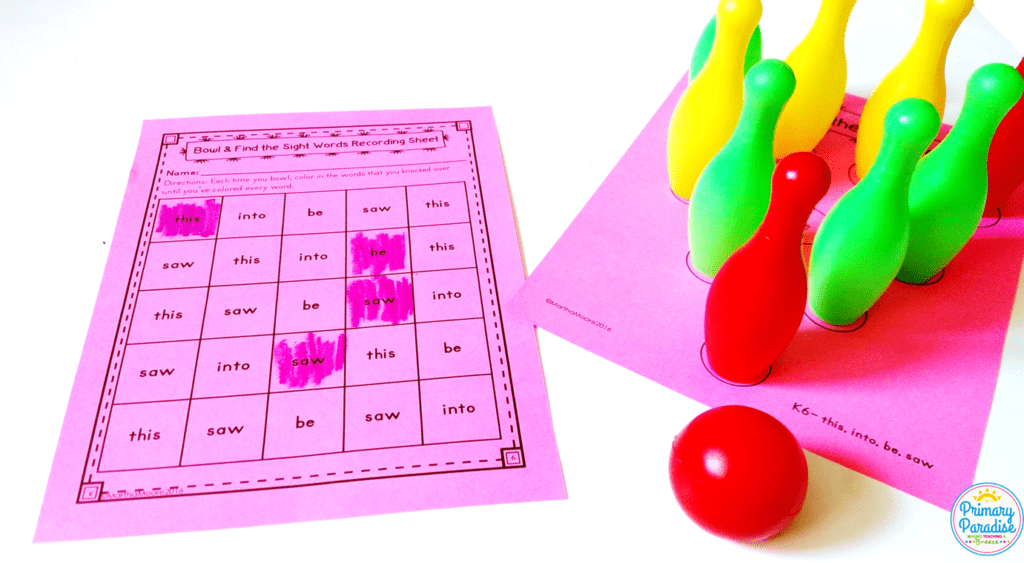
These bowl and learn sight word games are an absolute blast and really provide students who need to move an outlet for their wiggles. You can print out different boards and recording sheets (and there’s also an editable template so you can add your own words), but the game itself stays the same, which means it a great option. Students knock down the pins, color in the words they knock down, and repeat. The pins are from Dollar Tree. You can find similar pins on Amazon, or you can use toilet paper rolls or small cups.
Intensive Word Practice:
If you have a word that a student is really struggling with, this is my favorite option for a word work center. I would use this as an intensive word practice when a student is really, really struggling. There are many different options that allow the student to practice the word in lots of hands on ways to really help them grasp the word.
Work on Writing Centers
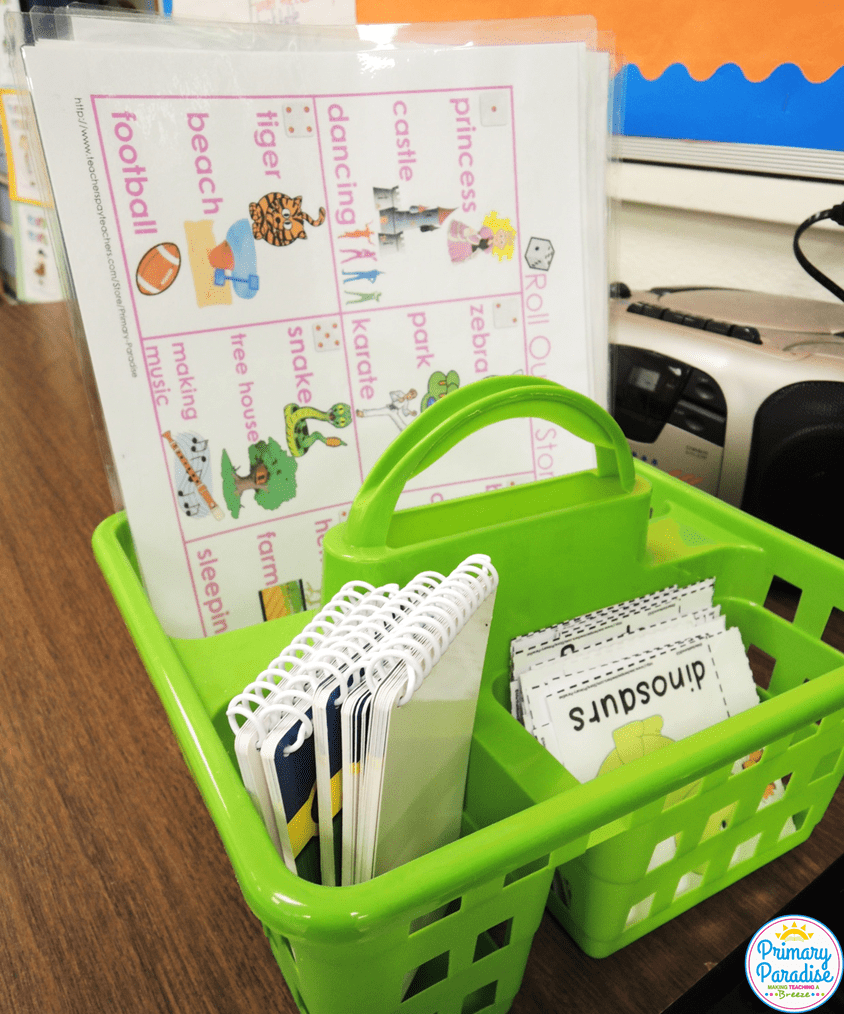
Are you still with me? Good! As I mentioned that the beginning of this post, the goal of writing centers is to write! So, I’m going to share my favorite centers that will allow you to basically set them and forget them!
A few more “housekeeping” items:
-I do not grade these writing pieces or require students to turn them in.
-All writing goes in their word work/writing journal.
-I DO spot check their journals once a month for accountability (which means I check everyone’s journal, read a page or two and write an encouraging note or put a sticker on a writing piece I like.)
Whole Class Journals:
Whole class journals are so much fun! Students absolutely love these because the topics are so open ended that they can write in them over and over. Students also love the community aspect! It’s wonderful for students to go through and read about other students’ thoughts, ideas, and experiences. They often will find they have things in common they didn’t realize, and it helps to form a class bond. I purchased the notebooks from the Dollar Tree and used packing tape to attach the labels. (Click here to purchase the editable covers pictured above.)
Roll a Story:
My goal with work on writing is to allow my students to write about different topics without a ton of prep for me. My Roll a Story center is the perfect option for writing centers because students can use them again and again and get a different story every time. I laminate these and they last year after year. If students finish their story, they simple roll again and write another. And, if for some reason the die is missing, they know to just pick a story option.
My Roll a Story Pack has recently been updated and expanded to include even more options!
Mystery Bag:
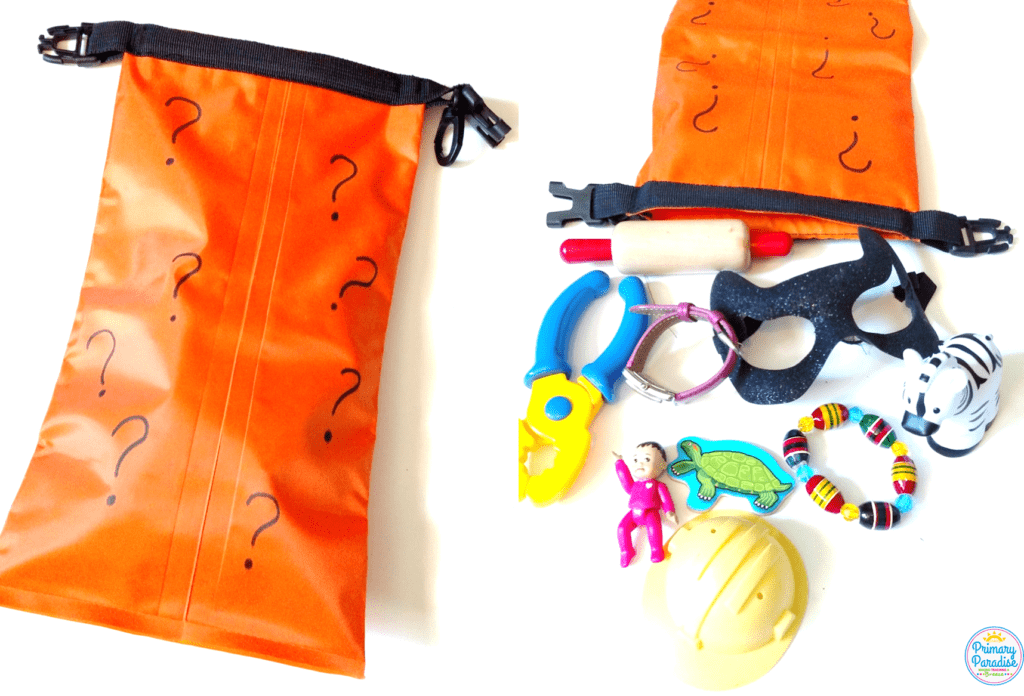
The hardest part of writing is knowing what to write about, so my mystery bag is a great option. This bag was from Dollar Tree, and I just wrote question marks all over it. Any bag would do. How it works is students reach in, pull out an object, and bring that object to their desk to write about it. Change up the different objects here and there to keep it interesting, but you can really put just about anything in it. Students can write a story about the object, describe the object, write clues describing the object- it’s really up to them. This is always a popular writing center, and it could even be a class job to select items for next week’s mystery bag! I typically just the items from the letter sound kits I have in my classroom as these tiny objects are perfect for this task!

Letter Writing Station:
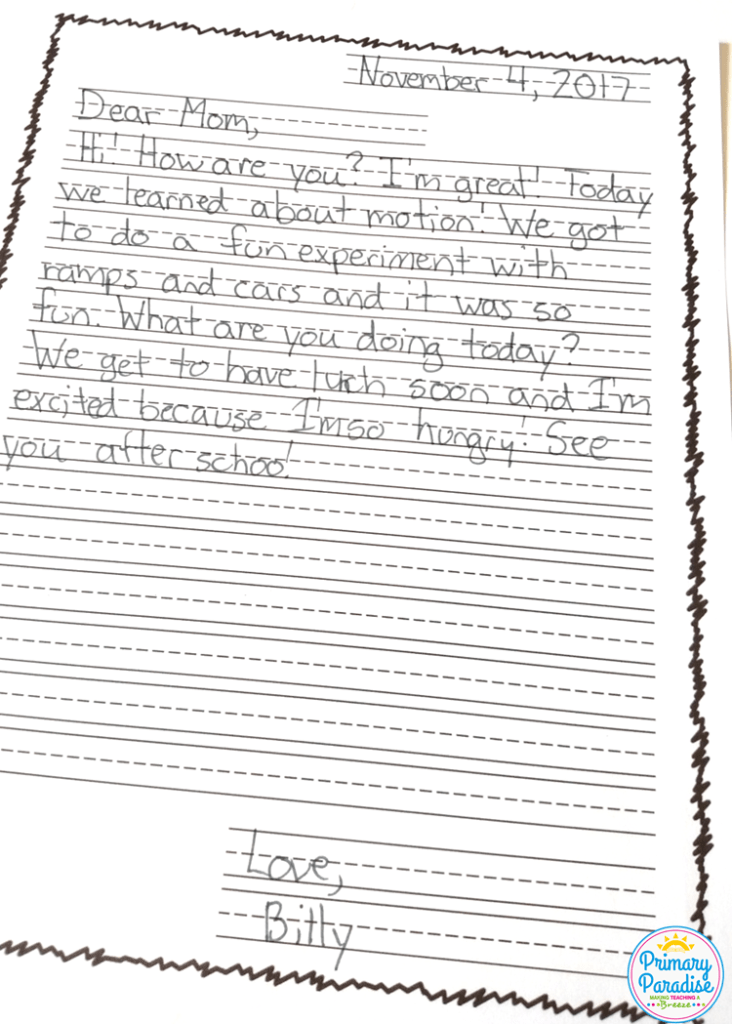
This option is so ridiculously simply, but always a such a hit. I just place a stack of letter writing template paper (which is available in my writing curriculum) in a bin. Students are allowed to write letters to whomever they wish. It could be to me, a friend in class, their mom, etc. This center is always an extremely popular choice. And if students finish their letter, they write another one (until time is up).
This is the ONLY writing that I require them to turn in. I always want to make sure any letters going to other students are kind. Also, most of the letters are normally to me. 😉 If the letter is to another student, after I read it I put it in that student’s mailbox. If it’s to one of their family members, I give it back to the student to take home, and if it’s to me, I always write a quick reply back (1-3 sentences max so it doesn’t take too much time).
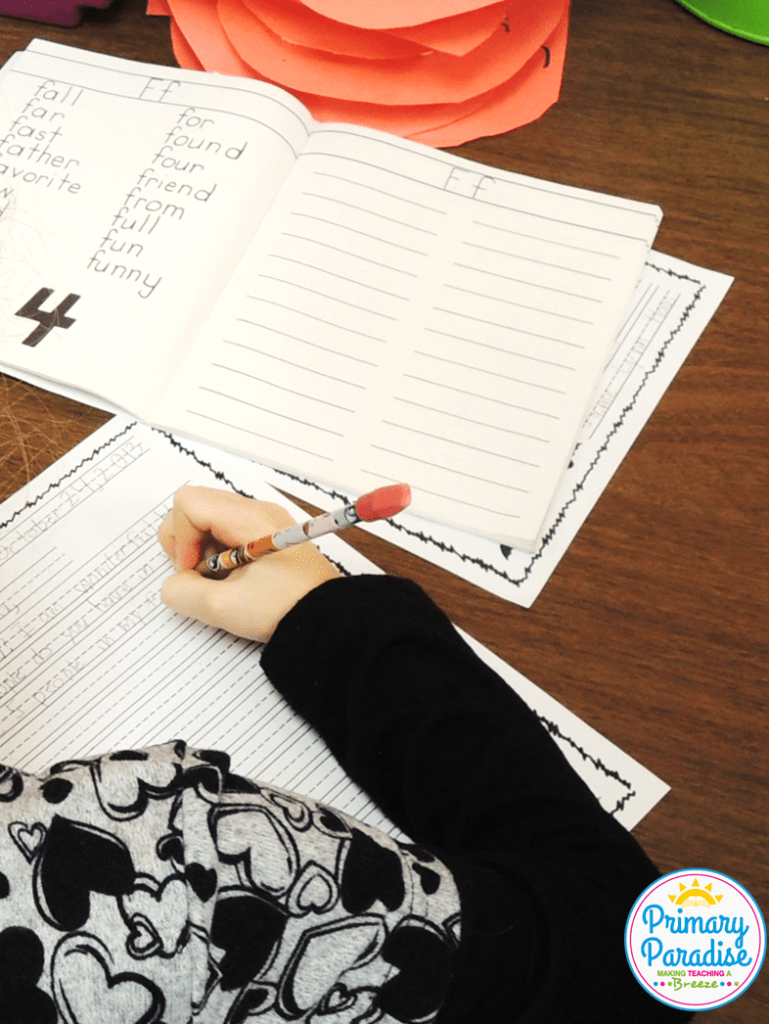
Build and Write

This center is a lot of fun for lego obsessed students or those who need something concrete. How it works is this. Students build something out of legos. Then, they either write to describe their lego creation or write a story inspired by what they built. A great addition to this center is a 2-3 minute sand timer. Tell students they only have that time to build and then they need to get started with writing.

Picture Prompts:
These writing prompts are an oldie but a goodie and work really well for younger students for writing centers (but also for older). Students select 3 writing prompts so that way, if they finishing writing about their first, they don’t have to go get another. These are a freebie from this old blog post.
Free Write Choices:
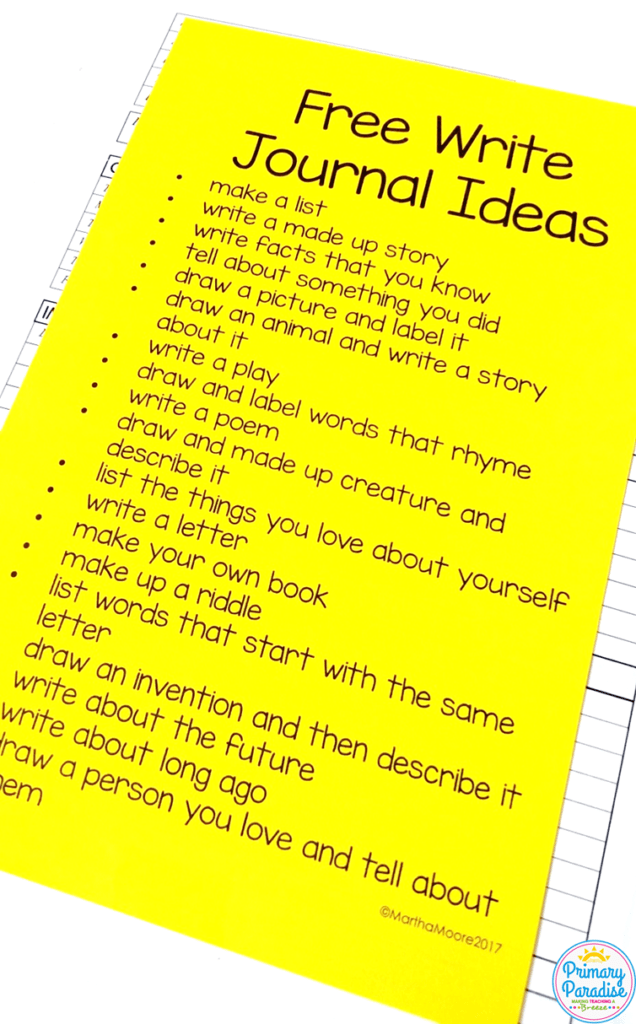
In the front of my word work and writing journals, I also include this list of options for writing. Sometimes my students just pick one of these, which is A-Ok with me. This is a freebie from this post.
The bottom line:
Word working and writing centers can be fun and engaging without you having to spend hours and hours cutting and prepping throughout the year. Instead, it can be fun by giving students choices that they are confident and comfortable using and by putting the emphasis on getting excited over learning new words! I don’t assign my students a center. When it’s word work time, they simply go over and choose a word work center, bring it to a comfy spot around the room, and get to work.
The same is true for work on writing. I’ve never had a student complain about being bored with these choices, but I have seen my students grow as wordsmiths and writers, and that, my friends, is what center time is all about.
Click the picture below to see how I set up my Listening to reading centers!
If you enjoyed this post, make sure to like, comment, and share!
You can join my FREE Facebook Club for k-2 teachers here!
AND BE SURE TO SIGN UP FOR MY NEWSLETTER FOR MORE TIPS, TRICKS, IDEAS AND FREEBIES!
